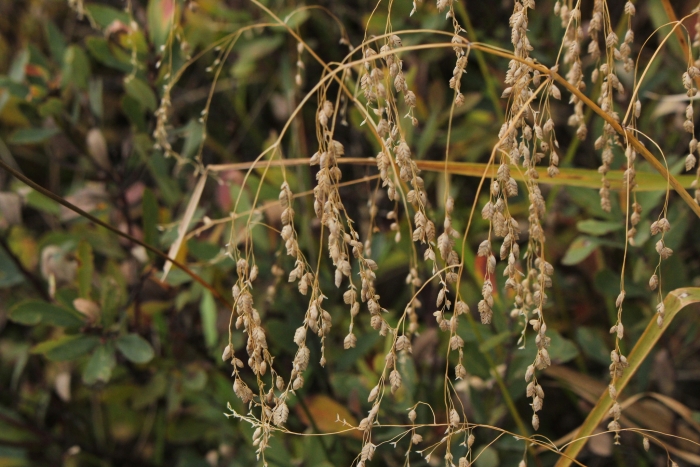Rattlesnake Mannagrass
(Glyceria canadensis)
Rattlesnake Mannagrass (Glyceria canadensis)
/
/

Quinten Wiegersma
CC BY 4.0
Image By:
Quinten Wiegersma
Recorded By:
Copyright:
CC BY 4.0
Copyright Notice:
Photo by: Quinten Wiegersma | License Type: CC BY 4.0 | License URL: http://creativecommons.org/licenses/by/4.0/ | Rights Holder: Quinten Wiegersma | Publisher: iNaturalist | Date Created: 2019-09-29T17:29:44-07:00 |
















































Estimated Native Range
Summary
Glyceria canadensis, commonly known as Rattlesnake Mannagrass, is a deciduous perennial grass native to wet meadows, marshes, and the edges of water bodies in the Northeastern United States and Canada. It typically grows up to 3 feet (1 meter) tall and forms dense clumps. The grass features an open panicle of flowers that appear from June to September, depending on the location. Each panicle is composed of drooping spikelets, which give the inflorescence a nodding, curved shape. The flowers are not particularly showy but add a fine-textured element to the landscape.
Rattlesnake Mannagrass is valued for its ability to thrive in wet conditions and is often used for soil stabilization near water bodies and in rain gardens. It is also appreciated for its wildlife value, as it provides habitat and food for various bird species. This grass prefers full sun to part shade and can adapt to a range of soil moisture conditions, from wet to moderately dry, making it versatile for different garden settings. While it is not known for significant pest or disease issues, it can spread vigorously in ideal conditions and may require management to prevent unwanted spread.CC BY-SA 4.0
Rattlesnake Mannagrass is valued for its ability to thrive in wet conditions and is often used for soil stabilization near water bodies and in rain gardens. It is also appreciated for its wildlife value, as it provides habitat and food for various bird species. This grass prefers full sun to part shade and can adapt to a range of soil moisture conditions, from wet to moderately dry, making it versatile for different garden settings. While it is not known for significant pest or disease issues, it can spread vigorously in ideal conditions and may require management to prevent unwanted spread.CC BY-SA 4.0
Plant Description
- Plant Type: Grass
- Height: 2-5 feet
- Width: 1-3 feet
- Growth Rate: Moderate
- Flower Color: N/A
- Flowering Season: Winter, Spring
- Leaf Retention: Evergreen
Growth Requirements
- Sun: Full Sun, Part Shade
- Water: Medium
- Drainage: Fast, Medium, Slow
Common Uses
Erosion Control, Low Maintenance, Water Garden
Natural Habitat
native to wet meadows, marshes, and the edges of water bodies in the Northeastern United States and Canada
Other Names
Common Names: Rattlesnake Grass, Rattlesnake Manna Grass
Scientific Names: , Glyceria canadensis, Glyceria laxa, Glyceria canadensis var. laxa, Panicularia canadensis, Panicularia laxa, Poa canadensis, Briza canadensis, Glyceria canadensis var. parviflora, Megastachya canadensis
GBIF Accepted Name: Glyceria canadensis (Michx.) Trin.